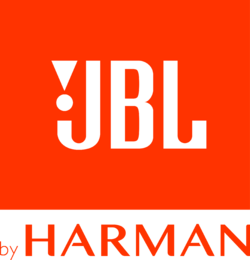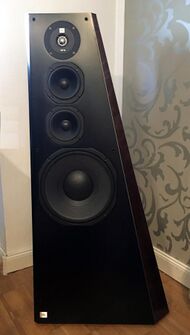Company:JBL
 | |
| Formerly | Lansing Sound |
|---|---|
| Type | Subsidiary |
| Industry | Audio |
| Founded | 1946 |
| Founder | James Bullough Lansing |
| Headquarters | Los Angeles, California, United States |
| Products | Amplifiers, loudspeakers, headphones |
| Owner | Samsung Electronics |
| Parent | Harman International Industries |
| Website | jbl |
JBL is an American audio equipment manufacturer[1] headquartered in Los Angeles , United States. JBL serves the customer home and professional market. The professional market includes studios, installed/tour/portable sound, music production, DJ, cinema markets. The home market includes high-end home amplification/speakers/headphones as well as high-end car audio. JBL is owned by Harman International, itself a subsidiary of Samsung Electronics.
JBL was founded by James Bullough Lansing (1902–1949), an American audio engineer and loudspeaker designer best known for establishing two audio companies that bear his name, Altec Lansing and JBL, the latter taken from his initials.
History
Lansing and his business partner Ken Decker started a company in 1927, in Los Angeles, manufacturing six- and eight-inch speaker drivers for radio consoles and radio sets. The firm was named Lansing Manufacturing Company, from March 1, 1927.[2]
In 1933, head of the Metro-Goldwyn-Mayer (MGM) sound department, Douglas Shearer, dissatisfied with the loudspeakers of Western Electric and RCA, decided to develop his own. John Hilliard, Robert Stephens, and John F. Blackburn were part of the team that developed the Shearer Horn, with Lansing Manufacturing producing the 285 compression driver and the 15XS bass driver. The Shearer Horn gave the desired improvements and Western Electric and RCA received the contracts to each build 75 units. Western Electric named them Diaphonics, and RCA used them in their RCA Photophones. Lansing Manufacturing was the only firm selling them as Shearer Horns. In 1936, the Shearer Horn received the Academy Scientific and Technical Award from the Academy of Motion Picture Arts and Sciences.

Based on the experience developed with the Shearer Horn, Lansing produced the Iconic System loudspeaker for cinemas. The Iconic was a two-way speaker using a 15-inch woofer for the low frequencies and a compression driver for the highs.
In 1939, Decker was killed in an airplane crash, the company soon began having financial troubles and, in 1941, Lansing Manufacturing Company was bought by Altec Service Corporation, after which the name changed to "Altec Lansing". After Lansing's contract expired in 1946, he left Altec Lansing and founded Lansing Sound in which later the name changed to "James B. Lansing Sound" and was further shortened to "JBL Sound".
In 1946, JBL produced their first products, the model D101 15-inch loudspeaker and the model D175 high-frequency driver. The D175 remained in the JBL catalog through the 1970s. Both of these were near-copies of Altec Lansing products. The first original product was the D130, a 15-inch transducer for which a variant remained in production for the next 55 years. The D130 featured a four-inch flat ribbon wire voice coil and Alnico V magnet. Two other products were the 12-inch D131 and the 8-inch D208 cone drivers.
The Marquardt Corporation gave the company early manufacturing space and a modest investment. William H. Thomas, the treasurer of Marquardt Corporation, represented Marquardt on Lansing's board of directors. In 1948, Marquardt took over operation of JBL. In 1949, Marquardt was purchased by General Tire Company. The new company, not interested in the loudspeaker business, severed ties with Lansing. Lansing reincorporated as James B. Lansing and moved the newly formed company to its first private location, on 2439 Fletcher Drive, Los Angeles.
A key to JBL's early development was Lansing's close business relationship with its primary supplier of Alnico V magnetic material, Robert Arnold of Arnold Engineering. Arnold saw JBL as an opportunity to sell Alnico V magnetic materials into a new market.
Lansing was noted as an innovative engineer, but a poor businessman. Decker, his business partner, had died in 1939 in an airplane crash. In the late 1940s, Lansing struggled to pay invoices and ship product. Possibly as a result of deteriorating business conditions and personal issues, he committed suicide on September 4, 1949. The company then passed into the hands of Bill Thomas, JBL's vice-president. Lansing had taken out a $10,000 life insurance policy, naming the company as the beneficiary, a decision that allowed Thomas to continue the company after Lansing's death. Soon after, Thomas purchased Mrs. Lansing's one-third interest in the company and became the sole owner. Thomas is credited with revitalizing the company and spearheading a period of strong growth for the two decades following the founding of JBL.[3]
Early products included the model 375 high-frequency driver and the 075 ultra high frequency (UHF) ring-radiator driver. The ring-radiator drivers are also known as "JBL bullets" because of their distinctive shape. The 375 was a re-invention of the Western Electric 594 driver but with an Alnico V magnet and a four-inch voice coil. The 375 shared the same basic magnet structure as the D-130 woofer. JBL engineers Ed May and Bart N. Locanthi created these designs.[4]
Two products from that era, the Hartsfield and the Paragon, continue to be highly desired on the collectors' market.
In 1955, the brand name JBL was introduced to resolve ongoing disputes with Altec Lansing Corporation. The company name "James B. Lansing Sound, Incorporated", was retained, but the logo name was changed to JBL with its distinctive exclamation point.[5]
The JBL 4320 series studio monitor was introduced through Capitol Records in Hollywood and became the standard monitor worldwide for its parent company, EMI. JBL's introduction to rock and roll music came via the adoption of the D130 loudspeaker by Leo Fender's Fender Guitar Company as the ideal driver for electric guitars.
In 1969, Thomas sold JBL to the Jervis Corporation (later renamed "Harman International"), headed by Sidney Harman. The 1970s saw JBL become a household brand, starting with the famous L-100, which was the bestselling loudspeaker model of any company to that time. The 1970s were also a time of major JBL expansion in the professional audio field from their studio monitors. By 1977, more recording studios were using JBL monitors than all other brands combined, according to a Billboard survey.[6] The JBL L-100 and 4310 control monitors were popular home speakers. In the late 1970s, the new L-series designs L15, L26, L46, L56, L86, L96, L112, L150, and later the L150A and flagship L250 were introduced with improved crossovers, ceramic magnet woofers, updated midrange drivers, and aluminum-deposition phenolic resin tweeters. In the mid-1980s, the designs were again updated and redesigned with a new titanium-deposition tweeter diaphragm. The new L-series designations being the L20T, L40T, L60T, L80T, L100T, the Ti-series 18Ti, 120Ti, 240Ti, and the flagship 250Ti. To test speaker drivers, JBL in Glendale and Northridge used the roof as an outdoor equivalent to an anechoic chamber.[7]
Over the next two decades, JBL went more mass-market with their consumer (Northridge) line of loudspeakers. At the same time, they made an entry into the high-end market with their project speakers, consisting of the Everest and K2 lines. JBL became a prominent supplier to the tour sound industry, their loudspeakers being employed by touring rock acts and music festivals. JBL products were the basis for the development of THX loudspeaker standard, which resulted in JBL becoming a popular cinema loudspeaker manufacturer.
JBL are currently fitted to vehicle manufacturers such as Toyota,[8] Kia[9] and Fiat.[10]
Timeline
- 1902 – Birth of James B. Lansing in Illinois, U.S.
- 1927 – Founding of Lansing Manufacturing Company in Los Angeles
- 1934 – Douglas Shearer from MGM designs the first speaker for the cinema. Lansing builds system components.
- 1941 – Altec Service Company acquires Lansing Manufacturing Company
- 1944 – Lansing and Hilliard redefine the reference theater speaker with model A-4, renamed Voice of the Theatre
- 1946 – JBL creates the original 'JBL signature' logo with exclamation (!) in black and white. Designed by Jerome Gould[11]
- 1946 – Lansing leaves Altec and founds a new company, James B. Lansing Sound Inc.
- 1947 – JBL has a 15" speaker (38 cm), model D-130, using for the first time a 4" (100 mm) voice coil in a speaker cone
- 1949 – James. B. Lansing dies of suicide; William Thomas became president of the company
- 1954 – The 375 compression engine is the first 4-inch engine sold; its response extends to 9 kHz
- 1954 – Presentation of acoustic lenses developed by Bart N. Locanthi
- 1955 – Leo Fender integrates the D-130 model in their amplifiers, thus starting the entry of JBL into professional music
- 1958 – Introduction of JBL Paragon stereo speaker system
- 1962 – JBL creates the first 2-way studio monitor, using a high-frequency motor lens
- 1967 - JBL creates the iconic red box logo with the exclamation (!) and white lettering. Designed by Arnold Wolfe, the president of JBL[12]
- 1968 – JBL launches the 3-way speaker 4310
- 1969 – Sidney Harman acquires JBL
- 1969 – L-100, a consumer version of the 4311 is launched; it would sell over 125,000 pairs in the 70s
- 1969 – JBL components deliver sound at Woodstock and many other rock festivals
- 1973 – 4300 Series launched, including the first 4-way speaker
- 1975 – 4682 Model Line Array Strongbox
- 1979 – Technology diamond surround for control of high frequency resonances in
- 1979 – Development of Symmetrical Field Geometry (SFG)
- 1980 – Pavilion Bi-Radial Constant dispersion technology
- 1981 – The first Bi-Radial monitor, 4400 for the recording studio
- 1982 – Titanium is used as a material for compression engines
- 1984 – JBL acquires UREI
- 1986 – The first models of Control series introduced
- 1990 – Vented Gap Cooling technology (reduces low frequencies transducer temperature)
- 1991 – The first pro-audio speaker based on neodymium with Array Series
- 1995 – Birth of EON system
- 1995 – First Neodymium Differential Drive speaker
- 1996 – Creation of the HLA standard with Line Array Space Frame design
- 1999 – JBL used at Woodstock 1999
- 2000 – Creation of VerTec Line Array system
- 2000 – Birth of EVO, the intelligent loudspeaker controlled by DSP
- 2002 – VerTec is used for the Super Bowl, the Grammy Awards and the ceremony of the 2002 FIFA World Cup (Seoul, Korea)
Product line examples
- JBL M2 Master Reference Monitor.jpg
JBL M2 Master Reference Studio Monitor
- JBL 708P.jpg
JBL 708P 8" Studio Monitor
- JBL L100 Classic.jpg
JBL L100 Classic Loudspeaker
- JBL VTX A12.png
JBL VTX A12 Line Array Loudspeaker
- JBL 308P MKII.webp
JBL 308P 8" MKII Studio Monitor
- JBL 4367.webp
JBL 4367 Loudspeaker
==
Examples of applications
- Academy of Motion Picture Arts and Sciences - AMPAS[13] (Samuel Goldwyn Theater, Hollywood, United States ).
- Institut de Recherche et de Coordination Acoustique/Musique - IRCAM[14] (Pierre Boulez, Paris, France , 1974–1991).
- Digital Cinema Project - GAUMONT[15] (Philippe Binant, Paris, France , 2000–2008).
See also
References
- ↑ "JBL Inc – Company Profile and News" (in en). https://www.bloomberg.com/profile/company/1352994D:US.
- ↑ McRitchie, Don. "6900 McKinley". http://www.audioheritage.org/html/perspectives/6900-mckinley.htm.
- ↑ [1] Founding JBL, Lansing Heritage website
- ↑ [2] JBL to 1981, Lansing Heritage website
- ↑ [3] JBL signature Logo, Lansing Heritage website
- ↑ "ARNOLD WOLF". http://www.audioheritage.org/html/people/wolf/wolf.htm.
- ↑ [4] Inside The Studio Monitor
- ↑ [5]"https://uk.jbl.com/toyota.html
- ↑ [6]"https://uk.jbl.com/kia.html
- ↑ [7]"https://uk.jbl.com/fiat.html
- ↑ https://1000logos.net/jbl-logo/
- ↑ https://1000logos.net/jbl-logo/
- ↑ [8] JBL, Cinema Loudspeaker Systems, p.1.
- ↑ [9] IRCAM, Rapport, p. 17.
- ↑ [10] JBL, Three-Way Screen Channel System, pp. 1-2.
External links
- No URL found. Please specify a URL here or add one to Wikidata.
 |

